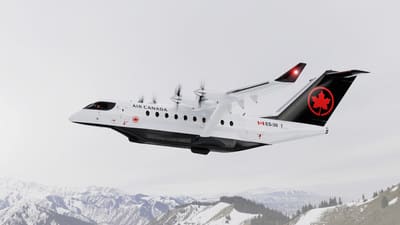Aerospace
Air Canada to Acquire 30 ES-30 Electric Regional Aircraft from Heart Aerospace
A purchase deal for 30 electric-hybrid ES-30 aircraft being developed by Swedish company Heart Aerospace was announced by Air Canada

A purchase deal for 30 electric-hybrid ES-30 aircraft being developed by Swedish company Heart Aerospace was announced by Air Canada. The ground-breaking regional aircraft, which is anticipated to enter service in 2028, would fly entirely on battery power with zero emissions and provide significant operational savings.
A $5 million equity share in Heart Aerospace has also been bought by Air Canada as part of the arrangement.
The introduction into our fleet of the ES-30 electric regional aircraft from Heart Aerospace will be a step forward to our goal of net zero emissions by 2050,” said Michael Rousseau, President and Chief Executive Officer of Air Canada.
The ES-30 will allow Air Canada to serve regional and commuter routes more sustainably, providing low-emission connectivity to local communities over the medium-to-long term.
It will be capable of carrying 30 passengers seated three across (in a 2X1 configuration), with a galley and lavatory. Air Canada has placed a purchase order for 30 ES-30.
Heart Aerospace values its strategic partnership with Air Canada. In addition to operating one of the largest regional turboprop networks in the world, the company is also forward-thinking and focused on the environment, according to Anders Forslund, founder and CEO of Heart Aerospace. With the ES-30, we can begin reducing air travel’s emissions long before the end of this decade.
The aircraft, which will be powered by lithium-ion batteries, will be quieter, more reliable, and have better operational parameters than traditional turbo-prop aircraft. Additionally, reserve hybrid generators that can run on sustainable aviation fuel will be included.
The ES-30 is expected to have an all-electric, 200 km range when fully loaded. With the help of the generators, this range can be increased to 400 km, and if the load is limited to 25 passengers, it can reach 800 km. The aircraft should charge in between 30 and 50 minutes.

Aerospace
Boeing Transfers Rocket Stage to NASA, Paving Way for Human Moon Mission

Boeing has achieved a significant milestone by providing NASA with the second core stage of the Space Launch System (SLS) rocket.
This crucial component, crafted at NASA’s Michoud Assembly Facility (MAF), is set to propel the Artemis II crew into lunar orbit, marking humanity’s return to deep space after a 50-year hiatus.
The monumental Boeing-built rocket stage, the largest element of the Artemis II mission, will embark on a journey aboard the Pegasus barge, traveling 900 miles to NASA’s Kennedy Space Center.
Comparison of two legendary aircraft B777x vs B747 aircraft:Click here
Upon arrival, it will be meticulously integrated with other essential Artemis II components, including the upper stage, solid rocket boosters, and NASA’s Orion spacecraft within the iconic Vehicle Assembly Building. This intricate integration process is a vital step toward the eagerly anticipated Artemis II launch, slated for 2025.
“Boeing-built products helped land humankind on the moon in 1969, and we’re proud to continue that legacy through the Artemis generation,” remarked Dave Dutcher, vice president and program manager for Boeing’s SLS program. “Together, with NASA and our industry partners and suppliers, we are building the world’s most capable rocket and paving the way to deep space through America’s rocket factory in New Orleans.”
NASA, Lockheed Martin Reveal X-59 Quiet Supersonic Aircraft:Click here
The delivery of Core Stage 2 marks a significant achievement in the evolution of the SLS rocket. Towering over 200 feet and powered by four RS-25 engines, this core stage, coupled with two solid-fueled booster rockets, will generate a staggering 8.8 million pounds of thrust. This immense power is crucial to launching Artemis II and future missions into the vast expanse of space.
The SLS rocket stands unparalleled in its capability to transport both crew and substantial cargo to the moon and beyond in a single launch. Its extraordinary capacity will facilitate the delivery of human-rated spacecraft, habitats, and scientific missions to destinations including the moon and Mars, ushering in a new era of space exploration.
-

 Travel1 week ago
Travel1 week agoAir India to Expand US Operations with Three New Routes After a Decade
-

 Travel2 weeks ago
Travel2 weeks agoWhy We Should Avoid These Stamps in a Passport
-

 Airlines1 month ago
Airlines1 month agoInvestigations Reveal Fake Chinese Titanium in Boeing and Airbus Jets
-

 Tech4 weeks ago
Tech4 weeks agoChina’s CATL Plans 1,800-Mile Electric Plane Launch by 2027
-

 Airport3 days ago
Airport3 days agoTop 10 Largest Airports in the World by Size
-

 Aerospace4 weeks ago
Aerospace4 weeks agoChina’s Fighter Jets Turn Wings into Autonomous Drones
-

 Airlines4 days ago
Airlines4 days agoAir India Rolls Out A350s for Delhi-New York JFK and Newark Routes
-

 Defence3 weeks ago
Defence3 weeks agoBoeing Enhances Chinook with New Engines and Block II Upgrades at $96 Million







